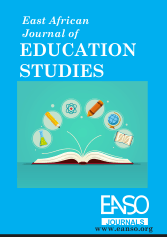Science Laboratory Availability and Functionality in Secondary Schools of Mbarara City, Uganda: A Qualitative Investigation
Abstract
The science laboratory is crucial for teaching general science and natural science subjects. It provides a space to apply theoretical knowledge and promotes engaging and visual learning. Students can express their creativity, ignite their enthusiasm for scientific inquiry, and develop their critical problem-solving abilities through hands-on experiences. This paper is part of the doctoral thesis, which aims to assess the state of science laboratories in secondary schools in Mbarara City, Uganda. The research was conducted in 36 secondary schools, which include both Government and Private schools in Mbarara City, from January 2025 to April 2025, to investigate and identify the issues in the science laboratories of schools. The study used a qualitative approach, and data was gathered based on the type of school, encompassing both government and private institutions, through interviews with 30 headteachers and non-participant observations of the laboratories of all selected 36 schools. The findings indicated that school laboratories mainly serve general purposes, with a notably inadequate system of specialized labs for each science discipline, particularly in private schools, due to limited funding and resources. 82.75% of the total sampled schools have inadequate resources. Regarding laboratory tools, chemicals, and specimens, government schools are generally better equipped than their private counterparts. Apart from the inadequate resources, other issues like teachers' unavailability, scarcity of books, and many other issues also arose, directly or indirectly hampering the science laboratory's availability and functionality. The study will shed light on the need for timely monitoring of different aspects of science laboratory teaching at schools. Each school was observed only once, restricting the range of teaching-learning activities and observer effect can influence conclusions based on observation and data analysis.
Downloads
References
Advanced secondary curriculum physics syllabus (2025), National Curriculum Development Center (NCDC)
Eitu, R. L. (2015). National Policy on Science Education and Science Teachers’ Performance in Secondary Schools in Mbale District (Uganda). Mbale: Islamic University in Uganda. Retrieved arch 2025, from http://hdl.handle.net/20.500.12309/367
Huang, Z., Ouyang, J., Huang, X., Yang, Y., & Lin, L. (2021). Explaining Donation Behavior in Medical Crowdfunding in Social Media. SAGE Open.
Isozaki, T. (2017). Laboratory Work as a Teaching Method: A Historical Case Study of the Institutionalization of Laboratory Science in Japan. Espacio, Tiempo y Educación, 4, 101-120. https://doi.org/10.14516/ete.177
Kiconco, M., & Karyarugokwo, D. (2022). A critical analysis of compulsory science education policy at the secondary level of education in Uganda. Advances in Social Science Research Journal, 9(8), 297–300.
Kit O. et al. (2023). Enhancing Science Education in the Twenty-First Century: Advancements and Applications of Laboratory Learning. 2835-3013. (https://www.researchgate.net/publication/371617471_Enhancing_Science_Education_in_the_Twenty-First_Century_Advancements_and_Applications_of_Laboratory_Learning)Kumari, P., Mwesigye, A & Balimuttajjo, S. (2024). Science laboratory education and students' perceived behavior towards science education: A review. Journal of Research Innovation and Implications in Education, 8(4), 555 – 561.
Lower secondary curriculum syllabus (2019), National Curriculum Development Center (NCDC)
Maate C. (2023). Teaching-learning facilities and students’ performance in chemistry in selected secondary schools in Kasese Municipality (PhD Thesis), Mbarara University of Science and Technology, Uganda.
Margaret, A. (2021). The Challenges and Prospects of Science Education Development in Africa. Mediterranean Journal of Social Sciences. 12. 120. 10.36941/mjss-2021-0033.
Muhangi G. (2019). Secondary Education in Uganda: Resource Mobilization and Efficiency, Journal of Education and Practice.
Naeem et al. (2023). A step-by-step process of thematic analysis to develop a conceptual model in qualitative research, International Journal of Qualitative Methods, 22, 1–18
Needham, B. (2014). Dutch Land-use Planning: The Principles and the Practice (1st ed.). Routledge.
Nowell et al. (2017). Thematic Analysis: Striving to Meet the Trustworthiness Criteria, International Journal of Qualitative Methods, 16, 1–13
Onanuga, P. A., & Saka, A. O. (2015). Trend Analysis of students’ academic performance in selected science, technology, engineering, and mathematics subjects in Ogun State Basic Education Certificate Examination (OG-BECE), Nigeria, from 2011 to 2015: a projection for five years. Science Education International, 29(2), 110-116.
Rukundo, A. & Bashaija, A. (2022). Prioritisation and Nationalization of Teaching of Sciences in Ugandan Schools: Practitioners and Documentary Perspectives. Interdisciplinary Journal of Education Research, 4(2), 15-27, 10.51986.
Third National Development Plan (NDPIII) 2020/21 – 2024/25. (July, 2020). National Planning Authority, Kampala, Uganda
Uganda National Examinations Board. (2017). Report on the work of candidates UCE 2016. Kampala, https://ereg.uneb.ac.ug/files/UCE2016RPTONWORKOFCANDS.pdf Uganda Professional Science Teacher’s Union. (2023, July 3). Key Factors Affecting Science education in Uganda and how to overcome.
Copyright (c) 2025 Preeti Kumari, Sudi Balimuttajjo

This work is licensed under a Creative Commons Attribution 4.0 International License.




























